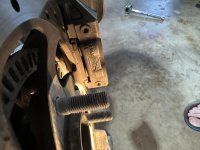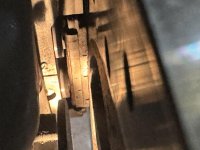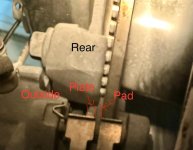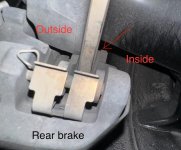Thanks but I’ve done that process a few times try to eliminate some brake squeal when actually braking. It helped some, but I still get the squeal intermittently, and it seems to vary with the brake temp. I’m more concerned about this constant rub. It seems like the caliper shouldn’t be resting on the rotor with no braking applied?
Are your discs getting hot while you're riding without any braking?? :dontknow:
If you can ride for a while, saaay, 5-10 mins or so without any braking, and then coast to a stop without any braking, maybe you could use a 'no-touch/remote/infra-red temperature gauge' to check/compare the temperature of the disc with the temp of the metal bits around it, like the rim, the brake caliper, the A-arms etc??? If there's no significant difference between those temps (ie, 100°C or more!

) then there's a good chance that you're worrying needlessly!

hyea:
But if the disc temp is over 100°C or so more than any of the surrounding metal bits, and you are
ABSOBLOOMINLUTELY SURE that you didn't even
THINK about touching the brakes in the last 10 minutes or so; &/or the disc temp itself is anything like 600° C or more, then you've most likely got a problem that needs addressing! :lecturef_smilie:
I would suggest that if you don't have an infra-red or no-touch thermometer handy, you might instead try using the '
Finger-tip test' that I learnt as a kid...
(Some of you might know of it... the test where you carefully edge your fingertip, preferably one that you don't use for too many other important things, closer & closer to the disc surface until either you can't bear to get it any closer or you actually touch the disc surface;
and if you don't immediately hear that sizzling sound you hear when you drop raw meat onto a red hot bbq plate &/or you don't instantly scream & pull your finger out & put it in your mouth in an attempt to alleviate the searing agony associated with burning your fingertip off at the same time as you start retching uncontrollably cos you've just brought the awful smell of incinerated flesh & fingernail right up close to your nose,
then your disc isn't really hot enough to worry about... - d'you know that one?! :shocked: )
but since the loss of two fingertips (yeah, yeah, I know already; but there
were TWO bloody front discs to check, weren't there! I know, I'm a slow learner, OK!

But at least once I learn something, it bloody well
STAYS learnt! :banghead: ) decades ago is now coming back to haunt me,
I don't think you really should do that... 
Altho, thinking about it..... it
has taken decades for the loss those fingertips & all feeling in the resulting scars to become a real problem for me, so if you don't think you've really got
too many decades left in you, then maybe you might....
Yeah, NO!! :lecturef_smilie:
Use a remote sensing thermometer to see if your disc/s is/are getting hot, and if not, then just....
Ride more, Worry Less! :thumbup:
,




